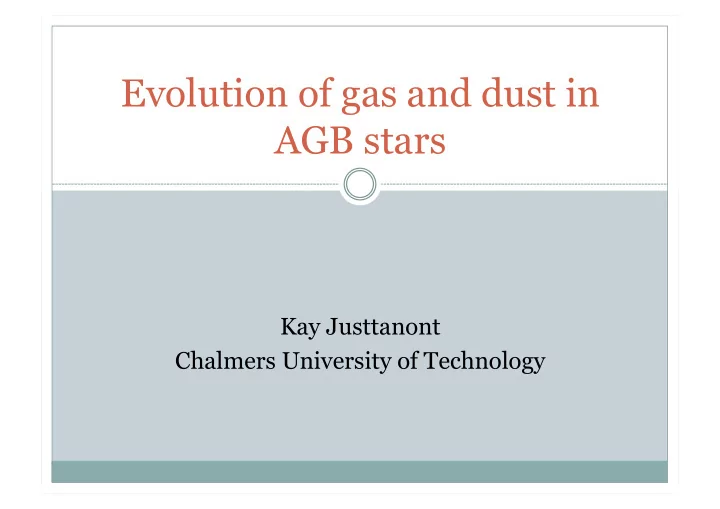

Evolution of gas and dust in AGB stars Kay Justtanont Chalmers University of Technology
Stellar evolution For low- and intermediate-mass stars, they enter the red giant and subsequently, asymptotic giant branch (AGB) phases. During the AGB, a star loses a significant of its initial main-sequence mass. Mass loss can be observed by studying dust and/or gas which form an extended circumstellar shell (CSE) around the star.
As the star evolves off the AGB, fast winds develop which impact on the AGB mass loss => shocks The central star becomes hotter and ionize the CSE around it => PDR.
Molecules in CSEs Since the photosphere is relatively cool, molecules can form and ejected via the mass-loss process. CSE environment also promote chemistry due to the cool, dense and warm conditions in the inner CSE. Molecules can be photodissociated in the outer part due to interstellar radiation field.
Molecules II Molecules detected depend on the C/O ratio of the photosphere. In M- (O-rich) stars , we observe H 2 O and other oxides.
R Dor – an O-rich CSE Justtanont et al., 2012, A&A 537, A144
Molecules II Molecules detected depend on the C/O ratio of the photosphere. In M- (O-rich) stars , we observe H 2 O and other oxides. In C-rich stars, we detect carboneceous molecules, e.g., C 2 H 2 , HCN, … (H 2 O)
HIFISTARS GTKP
Molecules II Molecules detected depend on the C/O ratio of the photosphere. In M- (O-rich) stars , we observe H 2 O and other oxides. In C-rich stars, we detect carboneceous molecules, e.g., C 2 H 2 , HCN, … (H 2 O) In S-star (C/O ~ 1), both oxides and C-base molecules have been seen.
Schöier et al., 2011, A&A 530, A83
Habing et al., 1994, A&A 286, 523
IRC+10 216 C-star which is the brightest source at 5 µ m. At a distance of 120 pc (Schöier & Olofsson 2000), it is one of the nearest C-stars with moderately high mass-loss rate and shows remarkable inventory of molecules. > 40 molecules have been detected, many carbon chains but also metal salts and hydrides.
Patel et al. 2011, ApJS 192, 17
H 2 O in IRC+10216 Decin et al., 2010, Nature 467, 64
Multiple shells seen in IRC+10216 Decin et al., 2011, A&A 534, 1
Masers Seen in O-rich CSEs Some transitions of OH, H 2 O, SiO can mase.
OH masers are thought to be radiatively pumped by the OH absorption doublet at 35 µ m.
From maser observations => magnetic field. OH44.8-2.3 Amiri et al., 2011, A&A, in press High angular resolution observations of proper motion of maser spots => distance
Dusty circumstellar envelopes The species of dust formed also reflect the chemistry in the photosphere. Oxides are formed in O-rich environment
Sloan et al., 2011, ApJ 729, 121
Silicate 10 µ m feature and mass-loss rate
Dusty circumstellar envelopes The species of dust formed also reflect the chemistry in the photosphere. Oxides are formed in O-rich environment Carbonaceous dust are observed in C-rich stars.
Speck et al., 2005, ApJ 634, 426
Dusty circumstellar envelopes The species of dust formed also reflect the chemistry in the photosphere. Oxides are formed in O-rich environment Carbonaceous dust are observed in C-rich stars. For S-stars, the dust is mainly oxides
Water-ice in extreme OH/IR stars OH 32.8-0.3 Waters et al., 1996 A&A 315, L361 Justtanont et al., 2006, A&A 450, 1051
Crystalline silicates OH 32.8-0.3 ISO-SWS HD161796 Hoogzaad et al., 2002, A&A 389, 547
Fosterite and enstatite in post-AGB stars Molster et al., 2002, A&A 382, 241
Fosterite (Mg 2 Sio 4 ) in post-AGB stars De Vries et al. 2011
Waters et al., 1996, A&A 315, L361
21 µ m feature in C-rich post-AGB stars Justtanont et al., 1996, A&A 309, 612
30 µ m feature in post-AGB stars : MgS Hrivnak et al., 2009, ApJ 694, 1147
PAHs in post-AGB stars and PNe Beintema et al., 1996, A&A 315, L369
Molecules in PPNe SUCCESS - Hershel open-time program
Bujarrabal et al., 2010 ,A&A 521, L3
Bujarrabal et al., 2010, A&A 521, L3
Shock chemistry and PDR Gas heating can be due to either shock or FUV photons. Line widths of molecular lines - shock? Cooling is done via atomic fine structure lines of [OI] and [CII] [OI] 63 / [CII] 158 is an indication of shock / PDR. [SI] 25 an indication of shock chemistry.
Recommend
More recommend